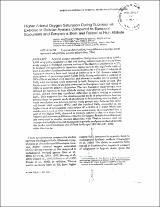Mostrar el registro sencillo del ítem
Higher arterial oxygen saturation during submaximal exercise in bolivian aymara compared to european sojourners and europeans born and raised at high altitude
| dc.contributor.author | Brutsaert, Tom D | |
| dc.contributor.author | Araoz, Mauricio | |
| dc.contributor.author | Soria, Rudy | |
| dc.contributor.author | Spielvogel, Hilde | |
| dc.contributor.author | Haas, Jere D | |
| dc.date.accessioned | 2021-05-21T16:34:57Z | |
| dc.date.available | 2021-05-21T16:34:57Z | |
| dc.date.issued | 2000 | |
| dc.identifier.uri | http://repositorio.umsa.bo/xmlui/handle/123456789/25217 | |
| dc.description.abstract | Abstract. Arterial oxygen saturation (SaO(2)) was measured at 3,600-3,850 m by pulse oximetry at rest and during submaximal exercise in three study groups: 1) highland Aymara natives of the Bolivian altiplano (n = 25); 2) lowland European/North American sojourners to the highlands with at least 2 months of acclimatization time to 3,600 m (n = 27); and 3) subjects of European ancestry born and raised at 3,600 m (n = 22). Aymara subjects maintained approximately 1 percentage point higher SaO(2) during submaximal work up to 70% of their maximal work capacity, and showed a smaller rate of decline in SaO(2) with increasing work compared to both European study groups. The higher-exercise SaO(2) of Aymara compared to Europeans born and raised at 3,600 m suggests genetic adaptation. The two European study groups, who differed by exposure to high altitude during their growth and development period, did not show any significant difference in either resting or exercise SaO(2). This suggests that the developmental mode of adaptation is less important than the genetic mode of adaptation in determining exercise SaO(2). A weak correlation was detected (across study groups only) between the residual forced vital capacity (FVC) and the residual SaO(2) measured at the highest level of submaximal work output (P = 0.024, R = 0.26). While firm conclusions based on this correlation are problematic, it is suggested that a part of the higher SaO(2) observed in Aymara natives is due to a larger lung volume and pulmonary diffusion capacity for oxygen. Results from this study are compared to similar studies conducted with Tibetan natives, and are interpreted in light of recent quantitative genetic analyses conducted in both the Andes and Himalayas. | es_ES |
| dc.language.iso | en | es_ES |
| dc.publisher | American Journal of Physical Anthropology | es_ES |
| dc.subject | HIPOXIA | es_ES |
| dc.subject | AMERINDIO | es_ES |
| dc.subject | CAPACIDAD DE DIFUSIÓN PULMONAR | es_ES |
| dc.subject | ADAPTACIÓN AL DESARROLLO | es_ES |
| dc.subject | ADAPTACIÓN GENÉTICA | es_ES |
| dc.subject | TIBET | es_ES |
| dc.title | Higher arterial oxygen saturation during submaximal exercise in bolivian aymara compared to european sojourners and europeans born and raised at high altitude | es_ES |
| dc.type | Article | es_ES |

